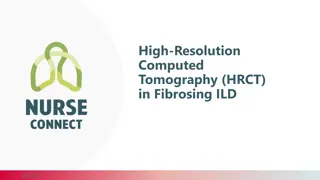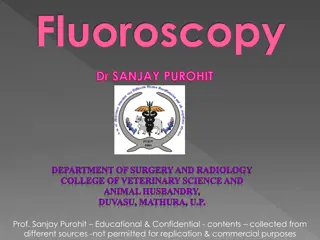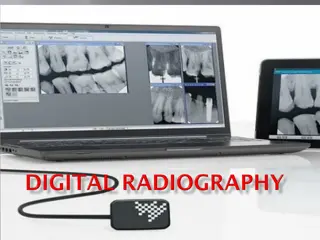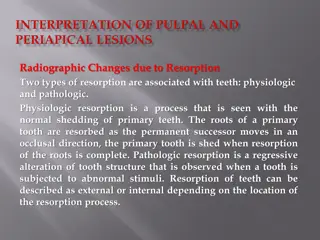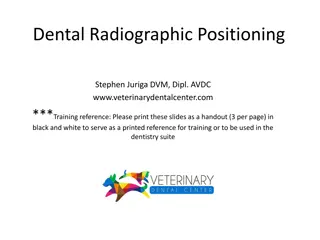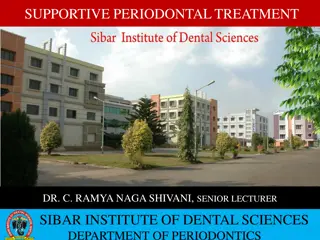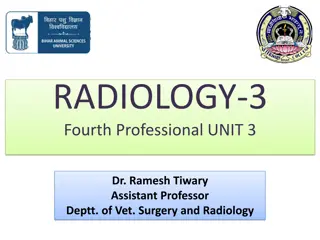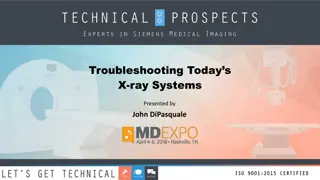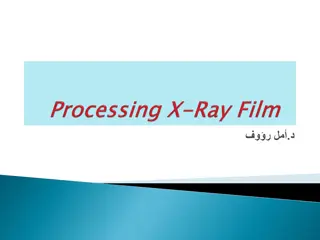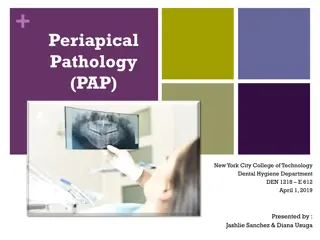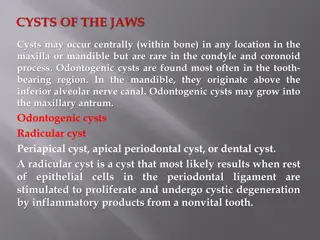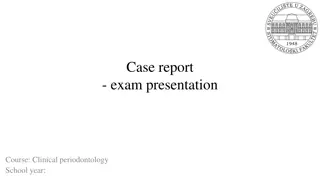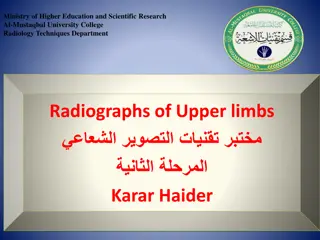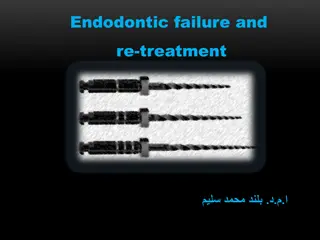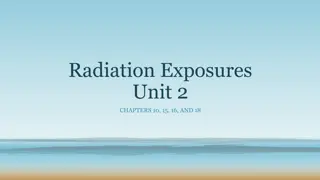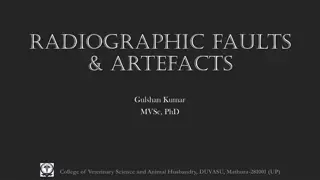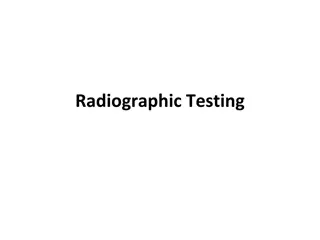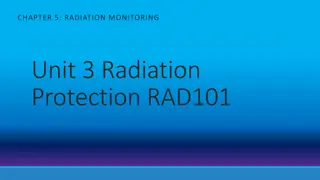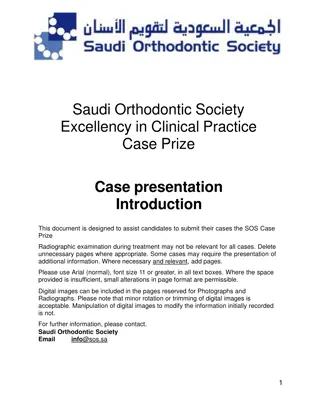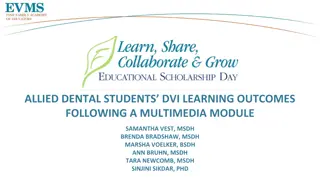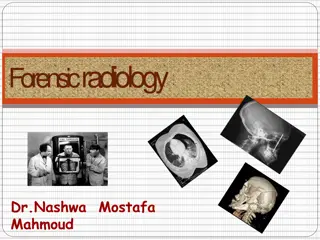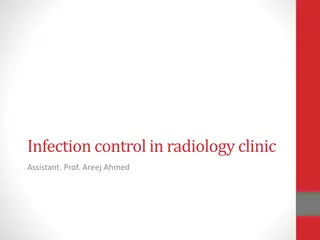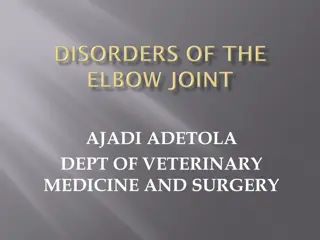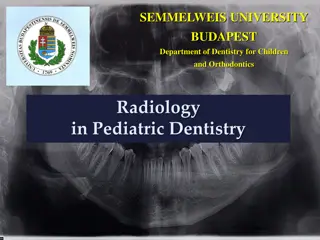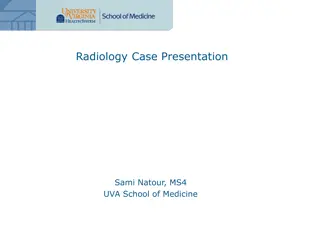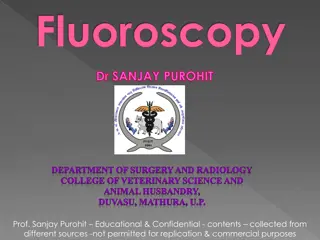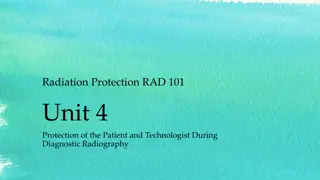Market Analysis (Project Formulation)
This detailed guide covers essential aspects of market analysis and project formulation in entrepreneurship, including feasibility analysis, techno-economic analysis, market demand analysis, steps in market analysis, and factors to consider for market demand analysis. Explore how to assess market de
2 views • 30 slides
Role of High-Resolution Computed Tomography in Fibrosing Interstitial Lung Diseases
HRCT plays a crucial role in diagnosing and monitoring fibrosing interstitial lung diseases (ILDs). It helps identify abnormalities not visible on X-rays, leading to early, accurate diagnoses and potentially avoiding invasive procedures. HRCT assists in distinguishing specific ILDs based on radiogra
1 views • 25 slides
Radiographic Imaging Methods of the Respiratory System
Radiographic imaging plays a crucial role in the evaluation and diagnosis of thoraco-mediastino-pleuro-pulmonary conditions. Techniques like radioscopy, digital radiography, computer tomography, magnetic resonance imaging, conventional pulmonary angiography, and hybrid imaging methods offer detailed
10 views • 21 slides
Overview of Jaw Cysts: Classification and Clinical Features
A cyst in the jaw is a fluid-filled cavity lined by epithelium that commonly occurs in the jawbones. There are different types of jaw cysts, such as odontogenic cysts and non-odontogenic cysts, each with specific clinical features and radiographic appearances. Understanding the classification and fe
9 views • 13 slides
Understanding Fluoroscopy in Veterinary Radiology
Fluoroscopy is a dynamic radiographic examination primarily managed by radiologists, with radiographers assisting in routine post-fluoroscopic radiography. The equipment involved includes X-ray tubes, C-arms, and image intensification tubes, which play crucial roles in enhancing image brightness and
1 views • 51 slides
Understanding Digital Radiography in Modern Healthcare
Digital radiography revolutionizes imaging by capturing, displaying, and storing radiographic images digitally, offering benefits such as dose reduction, image manipulation, and electronic transfer. While there are advantages like environmentally friendliness, it also comes with challenges like high
0 views • 25 slides
Understanding Radiographic Changes Due to Tooth Resorption
Tooth resorption can be classified into physiologic and pathologic types, with external and internal resorption processes affecting teeth differently. Physiologic resorption is natural during primary teeth shedding, while pathologic resorption is triggered by abnormal stimuli. External resorption oc
0 views • 13 slides
Comprehensive Cost Management Training Objectives
This detailed training agenda outlines a comprehensive program focusing on cost management, including an overview of cost management importance, cost object definition, cost assignment, analysis, and reporting. It covers topics such as understanding cost models, cost allocations, various types of an
2 views • 41 slides
Veterinary Dental Radiographic Positioning Techniques
Learn about common indications for dental radiographs in veterinary practice and proper patient positioning for accurate imaging. Explore techniques such as parallel view and the bisecting angle method for capturing quality dental X-rays. Enhance your skills in dental radiographic positioning for ef
0 views • 30 slides
Radiographic Imaging Processing Equipment Overview
The chapter delves into processing equipment for radiographic imaging, covering materials selection, manual processor construction, controls like thermostat regulators and inlet valves, and typical manual processing unit details. The content emphasizes factors like material resistance and cost, as w
0 views • 32 slides
Understanding Supportive Periodontal Treatment in Periodontics
Supportive Periodontal Treatment (SPT) is a crucial phase in periodontal therapy aimed at preventing disease recurrence and tooth loss. It involves regular maintenance and monitoring to manage periodontal conditions effectively. SPT includes thorough examinations, radiographic reviews, and prophylax
1 views • 61 slides
Understanding X-Ray Production and Interactions in Radiology
Explore the fundamentals of X-ray production, including the types of ionizing radiation and interactions of photons with matter. Learn about the photoelectric effect, Compton effect, and characteristics of X-ray tubes, essential for radiology professionals and students. Delve into the mechanisms beh
0 views • 17 slides
Troubleshooting Today's X-ray Systems by John DiPasquale
Gain insights into troubleshooting modern X-ray systems with a comprehensive guide presented by John DiPasquale. Explore X-ray system subsystems, including generator systems and imaging systems, with detailed explanations and visuals. Learn about the basics of generator systems, required circuits, a
1 views • 33 slides
Understanding X-Ray Film Processing Techniques
When a beam of photons exposes an X-ray film, it chemically alters the silver halide crystals, creating a latent image. Film processing involves developer, fixer, and a series of steps to convert the latent image into a visible radiographic image. The developer reduces silver ions in exposed crystal
0 views • 26 slides
Understanding Periapical Pathology in Dental Hygiene
Periapical pathology involves diseases around the tooth apex, such as abscesses, granulomas, cysts, and more. This presentation delves into identifying and differentiating these conditions, highlighting symptoms and radiographic features of each. Understanding these pathologies is crucial for dental
0 views • 12 slides
Understanding Odontogenic Cysts in Maxillofacial Region
Odontogenic cysts may occur centrally within bones of the maxilla and mandible, predominantly in tooth-bearing areas. Types include radicular cysts, residual cysts, and dentigerous cysts, each with distinct radiographic features and epicenter locations. Radicular cysts are commonly found around nonv
0 views • 7 slides
Understanding Achalasia: Therapeutic Approaches, Pathophysiology, and Clinical Manifestations
Achalasia is characterized by a failure of the lower esophageal sphincter to relax, leading to difficulty in swallowing and regurgitation. The exact cause is unknown, but autoimmune factors and chronic infections may play a role. Symptoms include dysphagia, chest pain, regurgitation, and weight loss
0 views • 59 slides
Comprehensive Clinical Periodontology Case Study Presentation
This comprehensive clinical periodontology case study presentation includes detailed information on the patient's general and dental history, oral hygiene assessment, periodontal diagnostics, radiographic analysis, occlusion evaluation, periodontal risk assessment, diagnosis, therapy plan, surgical
0 views • 15 slides
Radiology Techniques for Upper Limb Imaging at Al-Mustaqbal University College
Explore radiographic imaging techniques for upper limbs including fingers and thumbs at the Radiology Techniques Department of Al-Mustaqbal University College. Learn about PA, lateral, oblique, and AP views for detailed analysis. Proper positioning and imaging guidelines are provided to ensure accur
0 views • 20 slides
Comprehensive Guide to Neurological Examination in Dogs and Cats
Neurological examination in dogs and cats is crucial for diagnosing nervous system disorders. This guide covers the recording of history, general and detailed clinical examinations, examination of CSF, radiographic examination, EEG, and brain biopsy. It includes assessing history, mental state, move
0 views • 20 slides
Radiographic Evaluation of Olecranon Apophyseal Ossification System Guide
Comprehensive radiographic evaluation guide for the olecranon apophyseal ossification system, detailing stages from no ossification to complete fusion. Provides visual references and descriptions for each stage to aid in interpretation.
0 views • 11 slides
Evaluation of Success in Endodontic Treatment
Endodontic treatment success is crucial for patient well-being. Various criteria, including clinical, radiographic, and histological, are used to assess outcomes. Clinical signs like absence of pain and normal tooth mobility indicate successful treatment. Radiographic criteria involve checking for n
1 views • 44 slides
Understanding Filtration in Radiography
Filtration is a crucial process in radiography that involves eliminating undesirable low-energy photons to enhance image quality and reduce radiation dose to patients. This process involves using filters made of materials like aluminum to selectively absorb photons. Measurement of filtration is expr
0 views • 63 slides
Understanding Cryptococcal Immune Reconstitution Inflammatory Syndrome
Cryptococcal Immune Reconstitution Inflammatory Syndrome (C-IRIS) is a condition where rapid reversal of immunodeficiency triggers exaggerated inflammatory reactions in response to Cryptococcus antigens. It can manifest as either Unmasking IRIS or Paradoxical IRIS, with common CNS presentations incl
0 views • 10 slides
Understanding Radiographic Faults and Artefacts in Veterinary Imaging
Learn about radiographic faults and artefacts in veterinary radiography, including technical errors like motion artefacts, dark radiographs, gray non-contrast images, and light radiographs, as well as processing errors such as dark spots and white spots on radiographs. Discover the causes of these e
0 views • 12 slides
Subcutaneous Secukinumab in Psoriatic Arthritis: FUTURE 5 Study Results
The FUTURE 5 study examined the efficacy of subcutaneous secukinumab in inhibiting radiographic progression and improving clinical outcomes in psoriatic arthritis. Results showed significant improvement in ACR20, inhibition of structural damage progression, and resolution of enthesitis and dactyliti
0 views • 30 slides
Understanding Radiographic Testing: History, Science, and Radiation Safety
Exploring the history and science behind Radiographic Testing (RT), from the discovery of X-rays to the development of methods using gamma radiation. Learn about the terminology, natural radiation, and the characteristics of radiation in various forms. Understand the importance of safety measures in
0 views • 47 slides
Radiation Monitoring and Personnel Dosimetry: A Comprehensive Guide
This chapter delves into the importance of personnel dosimetry in radiation protection, covering topics such as dosimeter placement, types of dosimeters, radiation survey instruments, and calibration tools. It highlights the necessity for monitoring radiation exposure regularly to ensure safety with
0 views • 59 slides
Introduction to Static Analysis in C.K. Chen's Presentation
Explore the fundamentals of static analysis in C.K. Chen's presentation, covering topics such as common tools in Linux, disassembly, reverse assembly, and tips for static analysis. Discover how static analysis can be used to analyze malware without execution and learn about the information that can
0 views • 54 slides
Saudi Orthodontic Society Clinical Case Presentation Guide
This document assists candidates in submitting cases for the SOS Case Prize. It includes guidelines on patient assessment, occlusal features, pre-treatment photographs, casts, and radiographic examination findings.
1 views • 27 slides
Effects of Multimedia Module on Dental Students' Learning Outcomes
Current research explores the impact of a multimedia module on cognitive and affective learning outcomes among senior dental hygiene and dental assistant students. Findings reveal significant improvements in matching radiographic sets, knowledge of dental volunteer importance, and perceived knowledg
0 views • 11 slides
Introduction to Forensic Radiology: Techniques and Applications
Forensic radiology, as pioneered by Dr. Nashwa Mahmoud Mostafa, involves the use of radiographic techniques to assist in legal investigations and post-mortem examinations. Beginning with the historical overview of X-rays in forensic science, the field has evolved to utilize advanced imaging technolo
0 views • 68 slides
Industrial, Microbiological & Biochemical Analysis - Course Overview by Dr. Anant B. Kanagare
Dr. Anant B. Kanagare, an Assistant Professor at Deogiri College, Aurangabad, presents a comprehensive course on Industrial, Microbiological, and Biochemical Analysis (Course Code ACH502). The course covers topics such as Industrial Analysis, Microbiological Analysis, and Biochemical Analysis. Dr. K
0 views • 16 slides
Radiographic Infection Control in Dental Clinics
In dental radiology clinics, infection control is crucial to prevent cross-contamination and disease transmission among patients and staff. Key steps include applying standard precautions, wearing personal protective equipment, disinfecting equipment, and preventing contamination of processing equip
0 views • 16 slides
Benefits of Probabilistic Static Analysis for Improving Program Analysis
Probabilistic static analysis offers a novel approach to enhancing the accuracy and usefulness of program analysis results. By introducing probabilistic treatment in static analysis, uncertainties and imprecisions can be addressed, leading to more interpretable and actionable outcomes. This methodol
0 views • 11 slides
Understanding Elbow Joint Disorders in Veterinary Medicine
The elbow joint is a true diathrodial joint formed by the articulation of various structures. Disorders such as elbow luxation, un-united anconeal process, and fragmented coronoid process can lead to lameness and other clinical signs in animals. Causes include osteochondritis dissecans and trauma, w
0 views • 16 slides
Comprehensive Overview of Radiology in Pediatric Dentistry at Semmelweis University Budapest
Radiology plays a crucial role in diagnosing and treating diseases within the body, especially in pediatric dentistry at Semmelweis University Budapest. From the historical evolution of radiography to the modern radiologic diagnostic imaging techniques used in dentistry, this department utilizes a r
1 views • 40 slides
Radiology Case Presentation: Rocky Mountain Spotted Fever in a Young Female
A 34-year-old female with malaise, altered mental status, and thrombocytopenia was diagnosed with Rocky Mountain Spotted Fever after presenting with headache, chills, and somnolence following a trip to a wooded area. Despite initial puzzling symptoms and negative tickborne antibody tests, she showed
0 views • 9 slides
Understanding Fluoroscopy in Veterinary Surgery and Radiology
Fluoroscopy is a dynamic radiographic examination primarily used by radiologists in the Department of Surgery and Radiology at the College of Veterinary Science and Animal Husbandry, DUVASU. This imaging technology, discovered in 1896, involves X-ray tubes and image receptors mounted on a C-arm for
0 views • 51 slides
Radiation Protection in Diagnostic Radiography: Patient and Technologist Safety
Effective communication, immobilization, beam-limiting devices, beam filtration, gonadal shielding, exposure factors, IR combinations, good processing techniques, and reducing repeat radiographs are crucial for minimizing patient exposure during radiographic procedures. Equipment design features for
0 views • 49 slides

